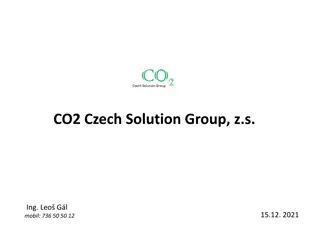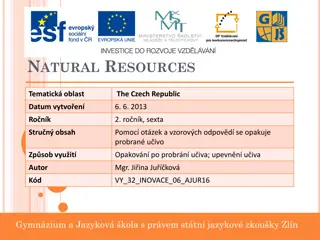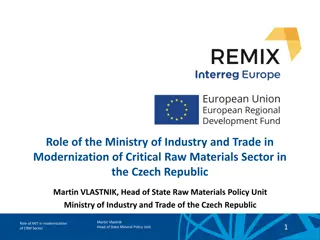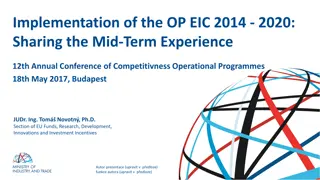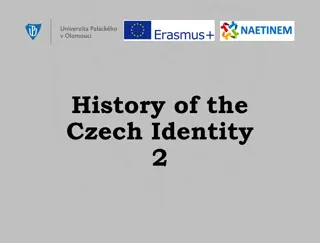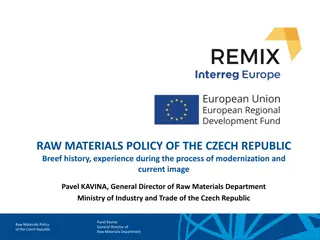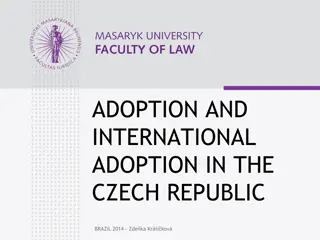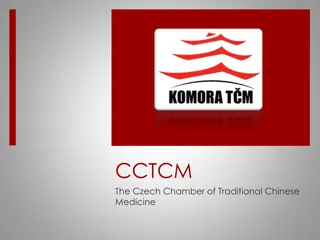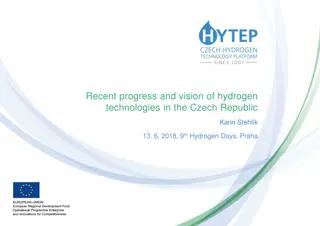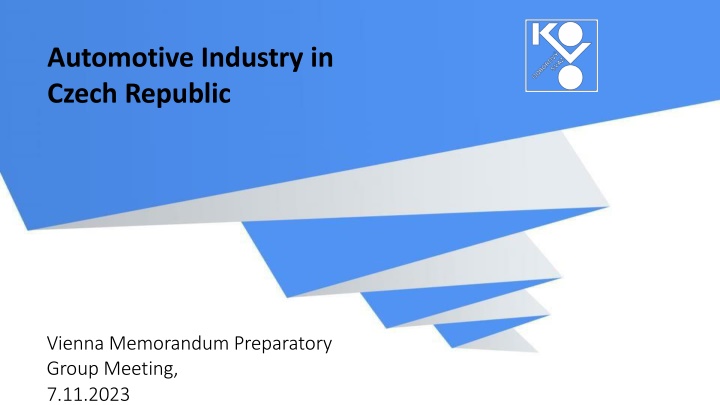
Automotive Industry in Czech Republic: Key Insights and Challenges
Total production of passenger vehicles, economic development indicators, investment trends, and sectoral challenges in the Czech automotive industry. Insights into growth, employment, foreign investments, and key issues faced by the sector.
Download Presentation

Please find below an Image/Link to download the presentation.
The content on the website is provided AS IS for your information and personal use only. It may not be sold, licensed, or shared on other websites without obtaining consent from the author. If you encounter any issues during the download, it is possible that the publisher has removed the file from their server.
You are allowed to download the files provided on this website for personal or commercial use, subject to the condition that they are used lawfully. All files are the property of their respective owners.
The content on the website is provided AS IS for your information and personal use only. It may not be sold, licensed, or shared on other websites without obtaining consent from the author.
E N D
Presentation Transcript
Automotive Industry in Czech Republic Vienna Memorandum Preparatory Group Meeting, 7.11.2023
Characteristics of the industry In the first nine months of this year, a total of 1,017,933 passenger vehicles were produced in the Czech Republic. This represents year-on-year growth of 11.5%. Despite the lower production results in September itself, which caused breakdowns in the supply of parts at the Cologne-based Toyota and koda Auto in Kvasiny, the threshold of one million manufactured vehicles was conquered a month earlier this year. The share of vehicles with electric drive is also growing, which currently represents 13,2 % of the total production of motor vehicles. A total of 97,992 purely electric and 36,332 passenger vehicles with plug-in hybrid drive.
Economic development of the industry Development of main economic indicators in Czech Automotive Industry CZ-NACE 29 AUTO Number of companies Sales (thousands of CZK) Employees Sales per 1 employee (thousands of CZK/empl./month) Agency workers Average wage (CZK/month) 2018 297 2019 305 2020 304 2021 302 2022 304 2022/2018 102,4 114,3 94,4 1st half 2023 303 856 583 884 163 769 1 223 903 639 1 249 248 262 1 187 418 951 1 247 951 618 1 398 343 339 174 319 175 089 169 363 169 045 164 558 585,1 24 669 37 975 594,6 23 712 40 093 584,3 19 032 40 240 615,2 18 917 42 059 708,1 20 060 46 093 121,0 81,3 121,4 871,7 22 480 50 666 Source: S , OS KOVO own calculations
Investments I. Between 2018 and 2022, the Czechinvest agency mediated 48 investment projects with an invested amount of CZK 34,054 million (EUR 1,384 million). 5,084 new jobs were created. Most of the investments were made in the Central Bohemian and Moravian-Silesian regions. The largest number of new jobs were created in Central Bohemia (1,696 jobs). Most jobs (1,508 jobs) were created thanks to Japanese investments.
Investments II. Investments according to country of origin: 2,82,00,50,5 4,1 4,3 27,2 5,6 7,5 7,9 22,5 15,2 Japonsko USA N mecko na R Francie pan lsko Korejsk rep. Nizozemsko Turecko It lie Indie
Problems of the sector Problems of the Czech Automotive Industry: 72% of sales in the Czech Republic are corporate customers All headquarters and development centres are outside the Czech Republic, decisions are made abroad about what and where will be produced, so the impact on a fair transition is minimal Concerns about the possible transfer of production to the mother countries - robots will be equally expensive everywhere Inadequate system of retraining, outdated education, which is no longer sufficient for market requirements the expertise of employees is decreasing, including those newly entering the labour market Extremely high input energy prices thanks to the policy of the Czech government Missing materials or components Low wages and a high number of foreign employees (agency employment) from countries outside the EU The Czech customer is not ready for electro mobility (high price) Global competition manufacturers outside the EU still produce internal combustion engines, they finance the development of new technologies from their profits, Europe will not be economically able to continue in the set direction
Health and Safety I. Health and Safety Digitalisation in the automotive industry has an impact on working conditions, the introduction of new technologies changes dangers and risks New challenges are emerging in the field of health and safety, especially of an ergonomic, organizational and psychosocial nature Musculoskeletal disorders - causes: Repetitive hand or arm movements Long sitting Lifting and moving heavy loads Psychosocial risks - causes Use of work pace systems Workplace monitoring (employee performance tracking) Lack of human communication (robotic workplaces) Isolation (remote work)
Health and Safety II. Examples from practice Initially, there were great discussions about whether employees on the production lines must be specially trained in the assembly of hybrids and EV cars, but in the end, practice has shown that this is not necessary, with a few exceptions. But what has turned out to be a potential problem is the ignition of electric cars from the batteries. It also happens that they catch these batteries in warehouses, that's why manufacturers of batteries for electric cars have trained firefighters, and they also have containers of water where these burning vehicles are closed, not extinguished. The reason for the ignition is often cheap parts for a few cents, which can be found even at the manufacturers of prestigious premium brands.
Automotive Future Production of batteries In the Czech Republic, there are stocks of key stocks of materials needed for the production of lithium battery cells (lithium, manganese, cobalt, ...). The problem is that mining is very non-ecological, high costs have to be incurred for its greening, so mining becomes significantly more expensive, and of course these high costs are ultimately paid for by the end customer. VW has not yet decided on the construction of a gigafactory for the production of batteries in Europe, the Czech Republic (L n near Pilsen), Slovakia, Hungary and Poland are in the game - indications are that Poland will be the winner.
Automotive Future In the Czech Republic, the Czech Battery Cluster was established in 2022, the aim of which is to ensure a partnership between the private and public sectors, supporting the cooperation of private companies, the research sphere and the public sector. Cluster visions Effective cooperation of scientific research institutions, private and public sector Technical education for the 21st century in close cooperation with the private sector Creation of new know-how linked to individual parts of the value chain Active participation in European and international projects and consortia Attracting foreign direct investment in batteries Retraining of existing employees Attracting and developing talent Planned activities Support and development of SMEs Cooperation between academia and SMEs on joint projects Access to funding sources Technical conferences and networking events Facilitation of outsourcing and branding Internationalization of members Human resource development and talent attraction services Feedback for public administration
Automotive Future Chip manufacturing Unfortunately, the investment by the Taiwanese company TSMC was won by Dresden, Germany The multinational chip manufacturer Onsemi in Ro nov pod Radho t m is investing 7.5 billion crowns in the expansion of production this year alone. Last year it was almost four billion. The Czech Republic is one of the three places under consideration, where this important semiconductor producer would like to invest even more money in the future. But the United States and South Korea are also in the game. What kind of incentives these countries come up with will be important in the decision. The decision in which of the three locations in the world Onsemi will massively invest in the expansion of chip production has not yet been made. According to Ale C b, the production director of the Ro nov company, a decision should be made by the end of February next year.
Automotive Future National Semiconductor Strategy HN 13.10.2023 The Czech Republic is following up on the European Chip Act by preparing a National Semiconductor Strategy. "It will map the types of chips in which the Czech industry has the greatest potential, and propose what support measures, including investments, to implement. And above all, it will help us set up the education system correctly, because the development of this industry cannot be done without enough qualified workers," Minister S kela explained in the summer. At the time, his ministry announced that it would complete the strategy in cooperation with experts in the first half of next year. But now it looks like he'll be a little faster at it. Preparations are designed to finalize the strategy by the end of this year," David Hlu t k from the press department of the Ministry of Industry and Trade told HN. Ministries collaborate on the strategy with associations that bring together representatives of the semiconductor chain.
Automotive Future Use of hydrogen National Hydrogen Strategy (2021) - being updated as it is out of date It is assumed that domestically produced hydrogen cars will not be produced for the Czech market, at least in the initial stages. In the short term, however, there is already the possibility of cooperation and involvement in the creation of entire passenger cars and targeting foreign markets. WEAKNESSES Competition from abroad already has a considerable lead Large foreign manufacturers may aim to produce on their own territory Lower purchasing power of residents in the Czech Republic compared to DE, AT Dependence on subcontracting The largest Czech car manufacturer's declared support for electromobility Current barriers to the development of hydrogen technologies in the Czech Republic Legislative-regulatory barriers (absence of laws, safety regulations, certifications, standards, lack of laboratory capacity for experimental activities) Technical-economic barriers (geographic-climatic conditions, limited readiness for distribution, storage and transportation) Rather, trucks and buses are being considered, projects for the production of green hydrogen exists
Automotive Future Synthetic fuels Production in the Czech Republic is still unimaginable, according to docent Pavel im ek, a fuel expert from the Technical University of Applied Sciences. He claims that the energy requirements of the production of synthetic fuels are enormous, while in the Czech Republic we do not even have any production capacity. The price is up to five times that of conventional fuels - an optimistic estimate that it will decrease to four times by 2050)
OS KOVO Priorities Trade Union Priorities Sustainable and reasonable energy prices Support for investment in the future of the automotive industry Construction of a high-quality education system, including a functional system of lifelong education No more cheap work Maintaining quality jobs, moving employees quickly between jobs, leaving no one without help

